In 1971, when the Lincoln Park main campus building was under construction, a tunnel was built to carry phone lines and other cables that fed all of the main building. For nearly 50 years, and despite campus expansion and dramatic changes in technology, the tunnel has continued to serve as a utility and communications lifeline on which the University's data centre, Wyckham House and the main building depend.
The tunnel extends from T-Wing in the northwest part of the main building to the end of E-Wing in the southeast. Despite looking like a relic of the past and being less than half a kilometre long, it's a vital artery, carrying utilities through the main building, supporting the IT data centre and connecting the University's central plant to the main electrical vault.
It's called a utility chase or raceway,' and it houses electrical wiring and panels, the central plant natural gas feed, telephone services and electrical and network cabling.
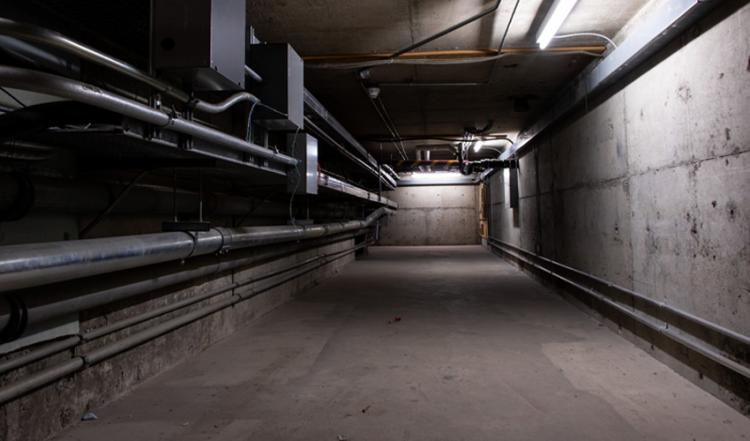
This is the first and shortest of the three sections of the tunnel, which starts in T-Wing. The entrance is a set of stairs to the left (not shown).
The middle and longest section of the tunnel stretches the length of Main Street. Where it leaves O/T-Wing it passes under the old library space, extending to the Science and Technology (B-Wing) near the East Gate entrance. From there, it runs under C-Wing, near Starbucks, and through to the end of E-Wing.
For a time, the tunnel was used as storage space for old furniture and audio-visual equipment, while still in use as a utilities artery. Uncomplicated and old, the tunnel remains vital infrastructure as it provides a passage for equipment that keeps the campus operating.
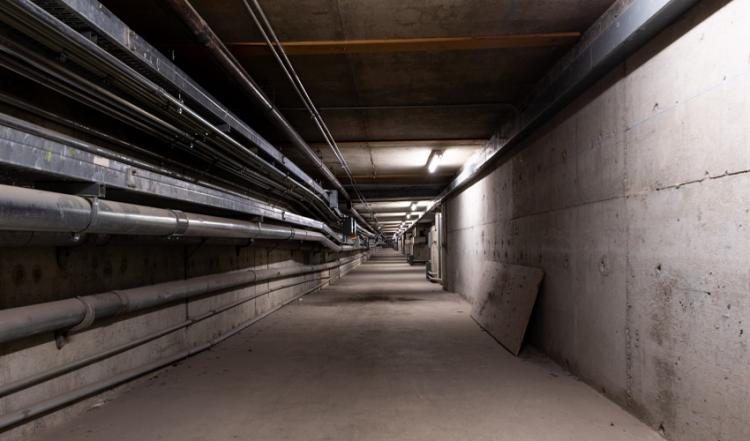
The middle and longest section runs under Main Street and the old library space.
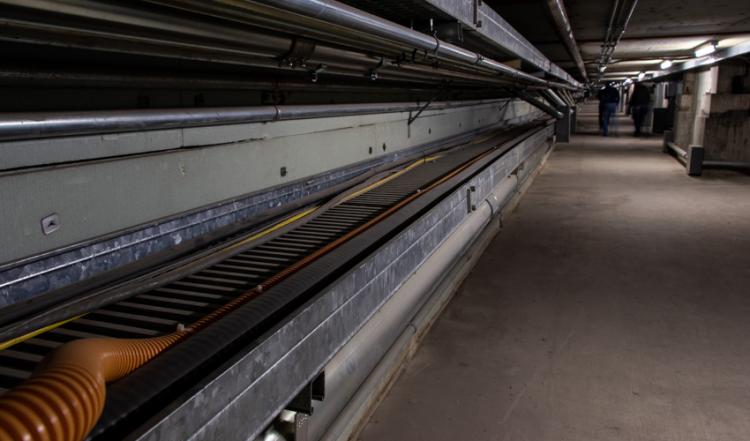
At left are the cable trays, which once supported large bundles of bulky, heavy cables that have now been replaced with much smaller ones still carried by the tray. The tray runs the full length of the tunnel, connecting important lines to the University's data centre. The Main Street elevator shaft is embedded in concrete, seen on the right.
When a cleanup of the tunnel was initiated several years ago, it took multiple trips in and out over three weeks to haul out decommissioned cabling and other equipment.
Otherwise cut off from the rest of the main building, the tunnel includes emergency lighting, speakers and fire alarms to alert anyone working down there of a problem aboveground. Constructed of concrete and steel, the tunnel itself is fire-resistant.

Every wire in the panels on the right once connected to an office landline. Banks of panels were placed throughout the tunnel sections in clusters that would have linked to large office areas on the floors above, like the old library.
Mount Royal's telephone system has changed significantly since 1971 equipment was installed. There used to be a central switchboard into which all of these lines fed. Today's phone system relies much more on software than hardware. All of the telephone lines for the main building enter through the tunnel.

Many of the panels, such as those on the left, are no longer in use as technology has evolved.
Housing the old and the new, the tunnel features artifacts from before the digital age while at the same time making it possible for new technologies to function and to serve a wide and busy space.
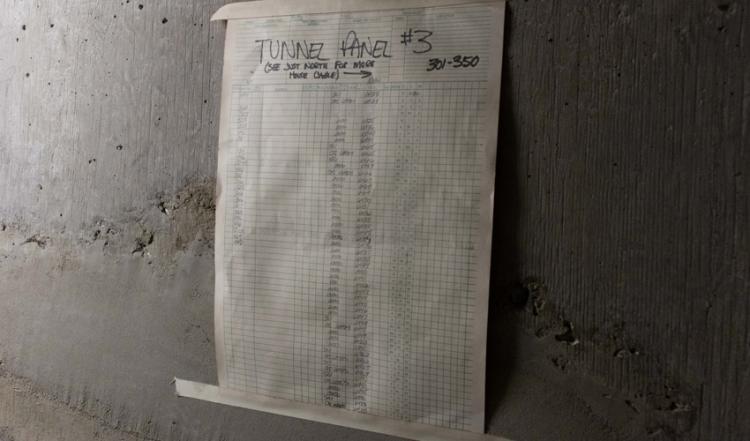
Individual extension numbers were recorded in pencil on sheets dating back to construction in 1971.
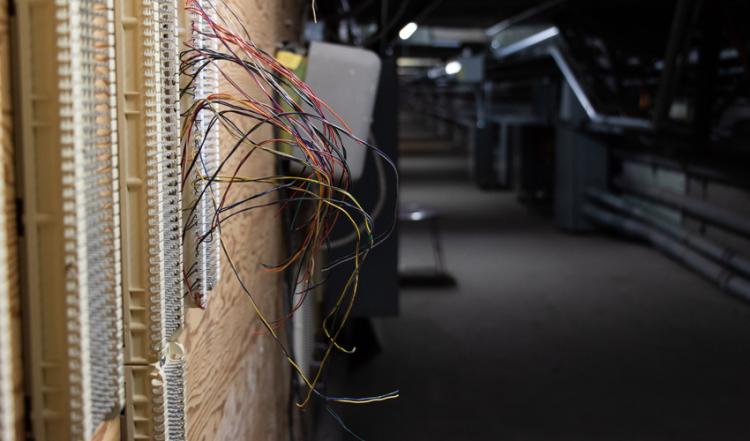
A relic of former technology, and an example of equipment that has been decommissioned and abandoned.
In 1985 the tunnel provided the solution when Building Operations needed to feed natural gas to the central plant from the incoming gas service located on the opposite side of the main campus building. A ventilation fan also had to be installed.
To feed two substations that provide electrical service to the central plant and Wyckham House, 13.2-volt conductors were also added. Most recently, in 2018, the tunnel was used for an emergency power distribution feed to the data centre, enabling Building Operations to tie-in backup generators for the EA and EB buildings when needed. Without the tunnel, it would have been necessary to build a new route, which would have been costly and disruptive.
From within the tunnel, large switches can shut down power to parts of the main building as well as the EA and EB buildings.
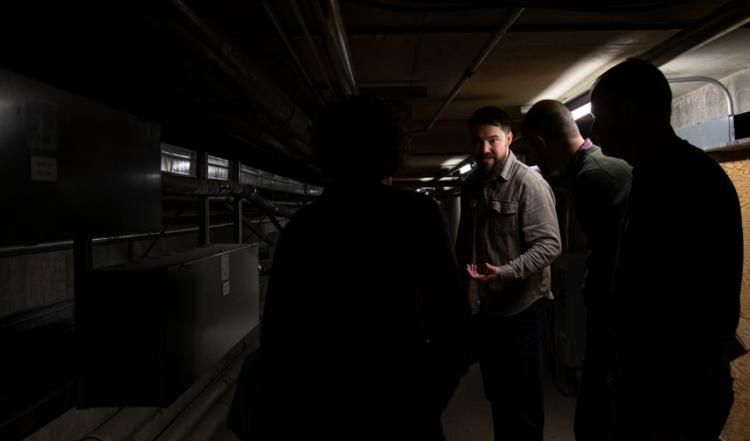
Manager of Building Operations Dylan Pritchard (centre), and Critical Systems Program Coordinator Glen Hogan (in silhouette, far right) lead a tour. As a 35-year employee, Hogan has spent more time in the tunnel than probably anyone else on campus.
The tunnel is stable and secure, even withstanding the 2013 flood, which saw the city's water table rise. At the tunnel's lowest point, a small groundwater weeping collection pit fills when the water table rises, but the tunnel itself stays dry.
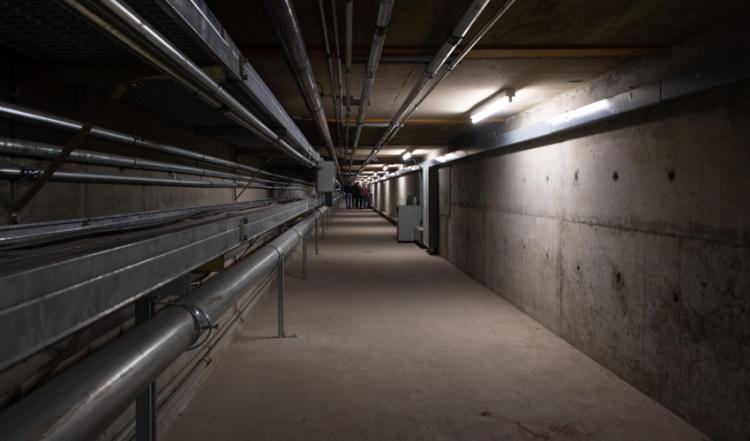
The final section extending under E-Wing. At left is a cable tray, with a second one running above.
With a low ceiling only five feet, nine inches in some sections utility workers and employees have been known to hit their heads on one of the beams or lines in the ceiling. A gas line was added through the tunnel in 1985 that shortened the ceiling even further in one section. A former employee, who was a short man, was often the one sent down to the tunnel because he was the only member of the department who didn't have to duck while in it.

Dylan Pritchard stoops as he walks under the last part of the tunnel, where the ceiling is shortest.
Both ends of the tunnel are secured. The entrances are unmarked and hard to find. Only ITS, Security and Building Operations have access, but on the rare time it's been left open, students have found their way in.
Secure, but not soundproof. Any drilling that needs to be done in the tunnel is scheduled for off hours because the noise would carry throughout the main building. An eight-inch concrete slab separates the tunnel from the Main Street floor.
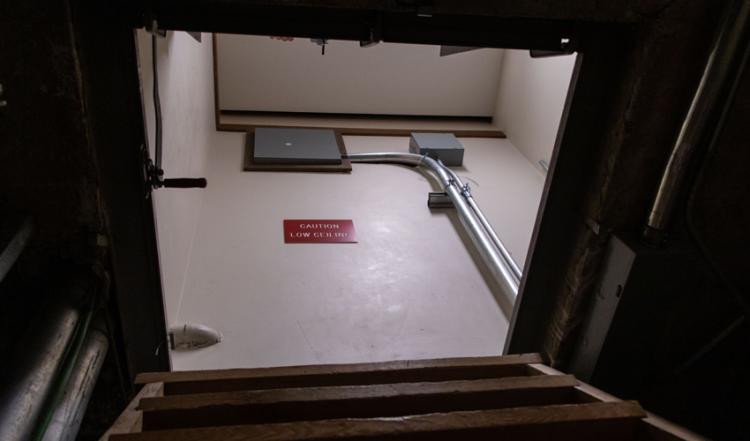
The tunnel ends where E-Wing ends. A stairway climbs up to a hatch, which opens into a closet inside a classroom.
On any given day, hundreds or even thousands of people tread over the tunnel along Main Street without ever knowing the old but vital corridor is there.

Busy Main Street, under which the tunnel extends.
By Melissa Rolfe










